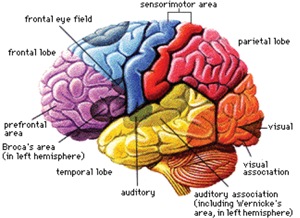What is sensory integration?
Sensory integration (sensory processing) refers to skills and performance in developing and co-ordinating sensory input, motor control and sensory feedback in a smooth and controlled process, for use in behavioural responses. More specifically, sensory integration is the organisation of sensory input for use in interpreting information about the body and its surroundings. The majority of children receive sensory signals in the normal way, but their brains are unable to organise the information. Some children may be over (hyper) sensitive and avoid input, whilst others may be under (hypo) sensitive and seek input.
Sensory integration therapy aims to improve the effectiveness and efficiency of processing and co-ordinating sensory information input from tactile (touch), vestibular (movement sense), proprioceptive (body position sense), visual (sight), auditory (hearing), olfactory (smell), and gustatory (taste) systems. Some of the areas of the brain concerned with processing information from the senses are illustrated in diagram 1.
Diagram 1: Some of the sensory processing areas of the brain.

Through sensory integration, many parts of the brain work together so that a person can interact with the environment effectively and experience appropriate achievement in daily activities. Sensory integration therapy provides controlled sensory input with the goal of increased adaptive behaviours/responses. A strong basis in sensory integration enhances development of higher level gross and fine motor skills. It also contributes to better self-esteem, self-control and improved attention span.
Sensory integration therapy
Sensory integration therapy may tone down sensitivity, or stimulate responses accordingly. The brain’s plasticity can develop new neural pathways as a result of the repetition of exercises used to overcome sensitivities. Responses to light, sound, smells, co-ordination and balance, and new motor sequences may be learned.
Through sensory integration, many parts of the brain work together so that a person can interact with the environment effectively and experience appropriate achievement in daily activities.
Specific problems
Children with sensory integrative dysfunctions may appear clumsy or disruptive despite normal family nurturing, because they cannot consciously control their motor skills or attention responses. They may appear to be slow to learn with limited activity. They may be passive, or over-aroused, demanding or hyperactive. Training may involve slowing down or speeding up responses to resolve the confusion within the brain. This has nothing to do with intelligence, which may be normal or above average. Over-sensitivity to sound requires training to filter out intrusive noises, and speech and language work uses many techniques, including singing and visual aids, to stimulate co-ordination of functions.
Signs of sensory dysfunction include:
- physical clumsiness
- difficulty learning new movements
- activity level unusually high or low
- poor body awareness
- inappropriate response to touch, movements, sights or sounds
- poor self-esteem
- social and / or emotional difficulties
- distractibility, impulsivity, limited attention control
- delays in speech, language and / or motor skills
- specific learning difficulties and / or perceptual difficulties
- poor self-care skills
- aversion to some foods/poor nutrition.
Disorders suitable for sensory integration therapy
The therapy is recommended for sensory integration disorder, ASD, autism, dyspraxia, Asperger’s syndrome, developmental delay, Down’s syndrome, global delay, fragile X, specific learning disorders such as dyslexia, dyspraxia, cerebral palsy, ADHD, and ADD, plus traumatic events prenatally, post-natally and in early childhood, as well as anxiety disorders.
However, there is a broader view of “occupations” that include children’s activities such as playing, learning and socializing with friends.
As a Pediatric occupational therapist, we provide evaluation, intervention and consultation in the following areas:
- Fine Motor / Handwriting Skills
- Play Development
- Sensory Integration
- Organizing and Planning their Motor Skills
- Oral Motor Functioning
- Handwriting
- Socialization
- Adaptive Equipment Modifications
- Environmental Adaptations for Home and School Settings
Pediatric and Neuro Speciality Clinic’s treatment rooms and innovative equipment is designed to mirror playful activities to the child, yet the therapist are actually drawing upon extensive training to provide challenging therapeutic activities aimed at developing greater capabilities and skill levels. There a scientific reason why a therapist is interacting in playful manner rather than it just being a play what a parents assume that can be done by them or school teachers etc.
- physical (reaching, rolling, crawling, and walking);
- cognitive (thinking, learning, solving problems);
- communication (talking, listening, understanding);
- social / emotional (playing, feeling secure and happy);
- feeding (breast feeding); and
- self-help (eating, dressing).
Examples of early intervention services: If an infant or toddler has a disability or a developmental delay in one or more of these developmental areas, that child will likely be eligible for early intervention services.

